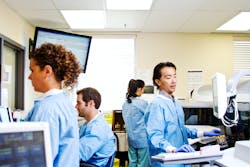Unlocking profit potential: Transforming hospital labs from cost centers to profit generators
Many administrators and C-suite executives tend to view their labs as an essential service, but not necessarily a profit-generating arm. This has led to a prevailing trend where lab directors outsource profitable testing to large reference labs, missing out on the opportunity to run these tests in-house for profit.
“Oftentimes, there is a lack of entrepreneurial thinking among hospital administrators with regard to their hospital laboratories,” says Jon Harol, President of Lighthouse Lab Services, a medical lab management, recruiting, and consulting firm. Despite the potential to bring profitable testing in-house, some health systems are outsourcing testing or selling their labs outright instead of exploring solutions to make them more profitable. Instead of accepting the status quo, Harol believes hospital labs should explore insourcing certain esoteric testing by focusing on adding high-margin tests that can both offset the cost of routine essential services and produce a profit for their hospitals in the long run.
“If you require a lab to be able to service patients 24/7 with a broad test menu, it’s very hard to operate that on a profitable model given reimbursement assigned for many of those tests by federal and commercial payers,” Harol says. “If you get so in the weeds that you only perform the low-margin testing and completely pass over higher-margin testing, that’s the worst-case scenario.” Some of the testing opportunities Harol cites include toxicology confirmation testing utilizing liquid chromatography-mass spectrometry (LCMS) and next-generation sequencing for cancer.
Challenges faced by hospital labs
Harol and his leadership team at Lighthouse recently conducted a panel of four hospital laboratory directors to try to better understand the challenges they face when advocating to add new lines of testing. Chief among the roadblocks cited by these leaders is the limited amount of time directors and lab managers can commit to compiling the business case for how new lines of testing can benefit their hospital’s bottom line, especially when considering many of these directors may lack a business background. Other challenges cited include the following:
Understaffing: This was the chief concern raised by each lab director since staff constraints limit their capacity to take on new testing while managing existing responsibilities. Key staffing challenges include difficult shifts/schedules, pay scale restraints, and low morale causing churn.
Skill set and validation: Esoteric testing often requires specialized skills for validation, and many hospital labs lack the necessary personnel with the required expertise and certifications, especially in smaller rural settings.
Capital approval: Getting approval for the capital required for new equipment, such as LCMS, often proves to be a significant hurdle. Those surveyed for this study each said they lack a seat at the table to properly advocate for themselves or raise these issues with their C-suite.
Lack of space: Many hospital labs face constraints due to limited lab space, potentially hindering the incorporation of new testing lines or required staff. One potential solution is to utilize space outside of the core lab for esoteric testing alongside the necessary courier infrastructure to support it.
Little incentive for existing staff: Due to the issue of existing staff already being stretched thin, panel members said there is sometimes little direct incentive for their teams to add new testing since they will be required to oversee it and will likely receive no additional support or compensation in the short term.
Making the business case
“For inpatient-only labs, bringing in new esoteric testing depends largely on the size of the hospital,” says Roger Newbury, Managing Director of Legend Consulting Group, which specializes in performing operational assessments for labs. Reviewing monthly send-out reports and the actual reference costs can help determine whether bringing this testing in-house makes sense for a given hospital lab.
“In order to make this successful, labs need to fully understand their costs and actual reimbursements, thoroughly analyzing the data for a better-informed decision,” Newbury says. “They need to work off the test reimbursements versus billed amount — reimbursement by carrier (payer) is the only valid data point.”
Harol echoes this point, adding that many lab directors can benefit from an advocate in their corner who can make the business case for why a particular test could lead to profit down the line for a hospital. “If a test is being sent out, in order to figure out whether it makes sense to bring it in-house, a lab director needs the time to make that case, aside from their day-to-day duties,” Harol says. “Oftentimes, it’s more than they have time and energy to commit to.”
Another opportunity: Strengthening outreach programs
“Hospital labs should also look to strengthen their outreach programs to collect potential high-margin testing that often doesn't reach their facilities due to local, in-network physicians directly sending samples to commercial labs,” Harol says. “Developing effective communication and outreach strategies to reach these physician practices can address this issue, ensuring that profitable testing stays within the hospital system.”
Overcoming these challenges: A proposed solution
Both Harol and Newbury say the solution to this advocacy and data issue is for hospital labs to partner with third-party groups who can provide the equipment, staff, and expertise needed to insource esoteric testing into hospital labs. Lab directors interviewed for the Lighthouse panel said they would be open to exploring a collaborative approach with a profit-sharing model, aligning incentives for both parties.
“When correctly armed with factual data, coupled with the right partner to provide the resources necessary to reconfigure the workflow without costing labs any funds, a very compelling argument can be made about adding this type of business,” Newbury says.
Looking ahead: Unlocking the full potential of hospital labs
In short, hospital labs should seek to shift their perspective, explore profitable in-house testing, and consider collaborative solutions with outside experts when their resources to advocate and build a business case for their labs are stretched thin. By addressing staffing, skill set, capital request, space, and outreach challenges, hospital labs have the potential to transform into profit-generating entities rather than be viewed simply as cost centers.
“Bringing profitable testing into the lab solves many of the issues currently plaguing labs today,” Harol notes. “Instead, health systems are selling their labs. We want to change that trend and the perception of hospital lab profitability as a whole.”





